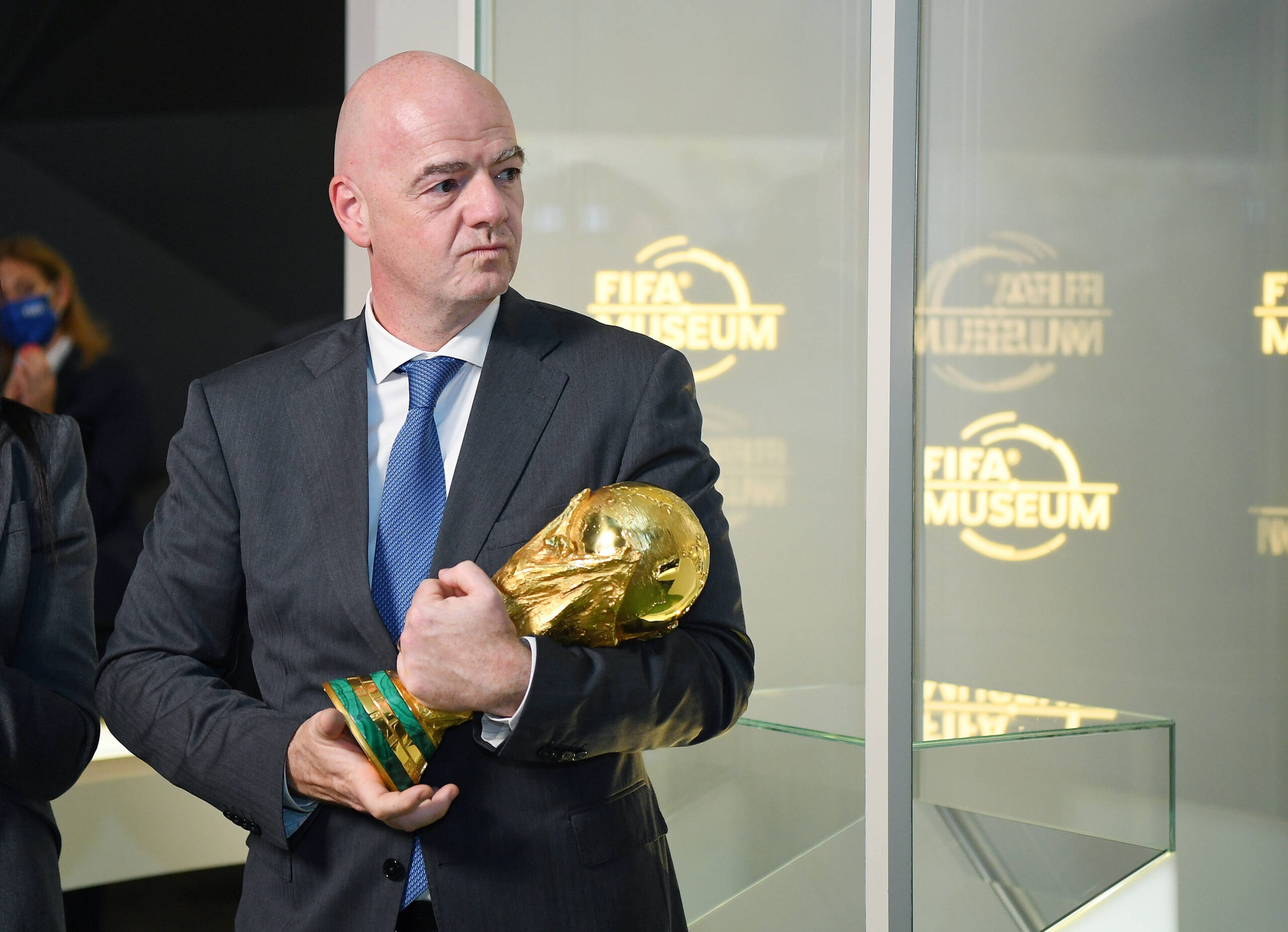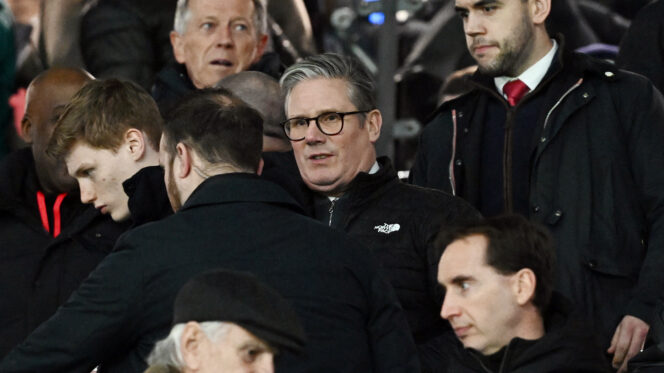The Fifa Museum Is a Masterclass in Reputational Whitewashing

There are three buildings in Zürich connected to football’s global governing body, or the Fédération Internationale de Football Association, or Fifa. The first is its headquarters in Zürichberg park, designed by Tilla Theus and completed in 2006 – formerly open to the public, but currently closed indefinitely to them. The second is the Fifa World Football Museum, opened 10 years later, on the other side of Lake Zürich, after Fifa decided not to put it on the grounds of their headquarters.
The third, unofficial yet infamous, is the five-star Hotel Baur au Lac, where in 2015 Swiss police officers arrested seven Fifa officials on behalf of the FBI, which had been investigating Fifa for corruption. Loretta Lynch, the US attorney general, alleged that the decisions to award the 2010 World Cup to South Africa, as well as to award the 2018 tournament to Russia and the 2022 tournament to Qatar, were invalid, since Fifa executives had taken bribes to vote.
Two days after the arrests, Blatter won a fifth term, having used his fourth to propose the museum and secure the venue, hoping to tie himself to Fifa’s global image and legacy. In fairness, Blatter achieved this, although not in the way he had hoped. Although he was not one of the 18 people extradited to the US and indicted, he resigned in December 2015 after Fifa’s ethics committee banned him for eight years. This followed a Swiss investigation, separate from the FBI one, alleging that Blatter – whose salary was never disclosed – had sold TV rights for the World Cup to Concacaf, the Caribbean and North American football association, at less than their market value, in return for votes in Fifa’s leadership elections.
In Switzerland recently for the Women’s European Championship – run by Europe’s governing body, Uefa, rather than Fifa – I couldn’t resist a visit to the Fifa museum, which had eventually been opened by Blatter’s successor, Gianni Infantino, on 28 February 2016.
I expected to find a huge gulf between how Fifa portrays itself and the reality of it, with an emphasis on the organisation’s role in staging the World Cup and some empty platitudes about how football “brings the world together” rather than anything about the bribery scandals, the human rights records of some of the men’s World Cup’s recent hosts, or the thousands of workers who died building the stadia for the 2022 tournament in Qatar. What I found was plenty of information about how Fifa was founded, how it took over the Olympic football tournament and superseded it with the World Cup, and a wealth of artefacts from 120 years of Fifa-organised competitions that would impress even the most disillusioned visitors.
The museum’s temporary exhibition immediately made Fifa’s current priority clear: the men’s Club World Cup, whose official ball and participating teams’ shirts greet you as you enter the building. First contested in 2000 with eight teams (when Manchester United famously withdrew from the FA Cup to participate), the Club World Cup bills itself as the only global club competition. This year’s new expanded edition, held in the US, featured 32 clubs, with Chelsea beating Paris Saint-Germain in the final. The tournament has attracted heavy criticism for packing yet more matches into players’ already-overloaded schedules for the sake of profit – $1bn (£743m) was shared between the clubs, with Chelsea getting £30m for winning and £84.5m in total, but mostly, the tournament was making money for advertisers, broadcasters and Fifa themselves.
The museum mentioned none of this, nor the “innovations” such as lengthy individual player (rather than team) walk-ons that Chelsea midfielder Roméo Lavia called “a bit of a showbiz thing”, and which look unlikely to catch on elsewhere. Many have ascribed this bright idea to Fifa’s long-term efforts to capture the elusive American market, from awarding the 1994 World Cup to the US despite it having no national league at the time, to Infantino’s shameless sucking up to Donald Trump – days before the Club World Cup final, Fifa announced that they would open a new office in Trump Tower in New York. Rather than dwelling on Infantino’s sycophancy, we get the shirts, the ball and concept drawings of the huge, orb-like trophy. There is no replica here, as Fifa already had to commission one to give to Chelsea after Infantino allowed Trump to keep the original Club World Cup trophy in the Oval Office, where it had been for months before the tournament, purely because Trump liked it.
Those aghast at Infantino’s collaboration with Trump would do well to remember that indifference to authoritarianism has always been Fifa’s modus operandi, something the museum notes only in passing. The museum’s World Cup gallery says “Italy staged and won the second World Cup … against a backdrop of Mussolini’s fascist propaganda”, without telling us who awarded the tournament to the then-fascist country, and whether they had any reservations about doing so, given the Italian dictator’s explicit use of the tournament as a propaganda tool. The failure to mention this, the arrests in 2015 or the bribery or human rights controversies around the Russia and Qatar tournaments, suggests that neither this ingratiation with Trump’s increasingly autocratic government nor its inevitable sportswashing through the 2026 World Cup will receive any serious interrogation.
The museum display on the 1978 World Cup in Argentina is maybe a better analogue for 2026: hosting rights were awarded to the country before the National Reorganisation Process established its military dictatorship, much as the US was awarded the 2026 World Cup before Trump won reelection. Of the 1978 tournament, the museum briefly says that protests against the “disappearance of thousands of people” took place, but omits that Amnesty International called for the tournament to be moved and that Fifa refused. The emphasis is placed on the ticker tape that covered the pitches, encapsulating “the euphoric mood of the nation [that] carried the team to the final”, rather than the fact that political prisoners in the nearby secret detention centre could hear the roars as Argentina won, a propaganda triumph for the regime. The head of the 1978 World Cup organising committee, Carlos Lacoste, was the cousin of de facto Argentinian president Jorge Videla and later became vice-president of Fifa, before being investigated for corruption after democracy was restored in 1983. This lack of self-awareness is disappointing, especially when you consider that just across the lake, the Kunsthaus has a huge exhibition reassessing the role that Nazi collaborating arms dealer Emil Bührle played in the gallery’s collection. Such self-criticism would surely not be beyond the scope of the Fifa museum.
Omissions aside, the museum is less self-aggrandising and more enjoyable than I’d expected, containing plenty of genuinely fascinating memorabilia. For many people, their love of football is bound up with their youth, and seeing the yellow card shown to Paul Gascoigne in the 1990 World Cup semi-final, provoking his famous tears, felt like an encounter with my own childhood. The same went for the two team sheets for the 1998 World Cup Final: the first showing Ronaldo left out of Brazil’s starting 11 after suffering a seizure in the dressing room; the second showing him back in (he made little impact on the match, which France won 3-0). Fifa owning the World Cup means they can dazzle audiences with the most prestigious and important items associated with it, including the original trophy introduced in 1974. There are displays on each tournament, including the women’s, launched in 1991 – the museum doesn’t say much about why that started 60 years after the men’s, but does at least acknowledge the unofficial one hosted in Mexico in 1971, including the programme and a ticket for the sold-out final.
There are plenty of shirts belonging to star players – Diego Maradona, Megan Rapinoe and Swiss legend Stéphane Chapuisat – and newspaper reports from notorious matches such as the Battle of Santiago at the 1962 World Cup, when Italy had two players sent off against their Chilean hosts. There are plenty of interactive sections in the museum drawing on the hugely successful Fifa video game franchise, allowing people to play various editions, from the first one from 1994, along with vitrines showing the history of football video games since the 1970s. There are fairground-style games where people can kick balls into goals, as well as displays about other football-themed games, from the internationally popular foosball to a British board game called Trench Football from 1915, where the player has to move a ball past the likes of von Hindenburg and Count Zeppelin into the goal – the kaiser’s mouth.
All of this is charming, funny and enjoyable – and never even raises the question of why few football fans hold Fifa’s officials in anything but contempt. I went to both the men’s and women’s Olympic football finals in Paris last year – the Parc des Princes crowd booed Infantino when he stepped up to award the medals (not for the first time). Perhaps aware of this, the museum includes little on its presidents. Presidents like the stuffy, conservative Sir Stanley Rous, who supported the apartheid-era South Africa team and demanded the USSR fulfil their scheduled World Cup qualifying play-off against Chile in Santiago when left-wing political prisoners were held in the Estadio Nacional after Pinochet’s fascist coup. (The Soviets refused, and Chile qualified automatically.) Presidents like João Havelange, the son of an arms dealer who expanded the World Cup and Fifa’s youth tournaments through sponsorship deals and the sale of global television rights, enriching himself as he turned Fifa into a worldwide organisation before he became embroiled in accusations of bribery. If you wanted to learn about these, the only place to do so was in the copy of David Goldblatt’s brilliant football history The Ball is Round, on sale in the museum gift shop.
In a comic irony, the museum itself has been caught up in a corruption scandal, largely unreported amidst the controversies around the men’s World Cups and the awarding of the 2034 edition to Saudi Arabia. In December 2020, Fifa itself launched legal action about the CHF500m (£466m) museum project, alleging that Blatter was part of a “suspected criminal mismanagement” that “unnecessarily consum[ed] vast sums of money that could and should have been used to support the development of football”. The decision to house the museum in a building owned by Swiss Life, with its huge real estate portfolio, had locked Fifa into above-market rent for 30 years. The tenants are also paying CHF140m (£130m) to renovate the building. Fifa’s audit said no other locations were considered, and alleged that officials were misled about the museum’s cost and viability – it made just $3m (£2.3m) of Fifa’s $766m (£576m) revenues in 2019. Blatter denied the allegations, which were dismissed by the Zurich prosecutor in 2023 (and are, of course, not mentioned in the museum).
Googling ‘Fifa Museum visitor numbers’ for this article, all but one entry on the first page of results came from the Museum itself, trumpeting its “record-breaking” footfall in 2023 and its “global expansion” the following year. Plenty of people were there, like me, on the day of the Germany-Spain semi-final in Zürich, looking at the museum’s little display about the history of women’s football in Switzerland. I doubt many left under any illusions about the nature of Fifa – nobody with even a passing interest in football could have missed the corruption allegations and patent profiteering, even if they didn’t know about the cosying up to Mussolini and Trump – but the playful joy they took in the exhibitions, films and games suggests that the organisation still has a huge, if captive, audience. After all, what are football fans going to do – set up their own global governance body?
Juliet Jacques is a writer, filmmaker, broadcaster and academic.


